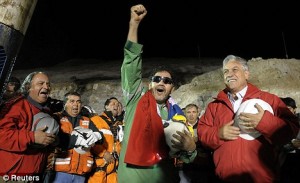Back in early September I first came upon the tale of the Chilean Miners in a Sunday newspaper. It detailed their story up to that point, the collapse that confined them to a network of mine shafts and tunnels under the Atacama desert and the precarious state of the mining company that employed them.
The article recounted the details of the various personalities of the people concerned. The difficulties in attempting a rescue that had never been done before. But, even then the mood music was that the Chileans were determined to do something about this.
It invited a piece of reportage a la Gabriel Garcia Marquez. You can almost imagine the description:
It was inevitable. When Mario Sepulveda Espinace heard the rolling thunder and smelt the choking dust it always reminded him of his childhood on his grandfather’s motorcycle and the smell of burning oil. But this time the sound and the smell would give him an entirely different memory. He found the tunnel to the main lift filled with boulders and he knew that the next few days would be interesting to say the least.
I remarked to my wife that some of the men would have difficulty being rescued due to their girth and pointed out that I would likely be in that category if I was stuck in a mine. I also added that spending time underground away from everyone and all the doom and gloom of the world above would indeed have its attractions for me…
But truly aside from the bad taste jokes and there have been plenty, who can imagine what it was like in that mine especially for the first seventeen days, before the drill head broke through into the miners’ chamber and with it the first rays of hope.
Apparently the 33 miners have agreed that what happened in the mine stays in the mine, but inevitably people’s minds have come round to exploring what would have happened had they not been rescued. A number of spectres raise their head, and the hairs on your neck.
Instead, what happened shone like a beacon to the rest of the world. Between them Chilean engineers constructed a rescue pod that looks like something from the Wonderpets children’s TV show. 21 inches wide, the thought of shooting up that claustrophobic channel in such a confined space. But with what the alternative?
The sight of the engineers and rescue teams clustered round a small manhole the size of a sewer head. The image of the Fenix 2 emerging from the channel. And the triumphant step forward of each miner wearing a pair of groovy sunglasses and a hard hat, straight into the waiting embrace of mother, father, son, daughter, mistress and el presidente himself.
My favourite part of this tale is how normal these people are. One guy has some serious explaining to do as both his wife and mistress turned up at the pit head to show their concern. The wife headed home in disgust and annoyance – I can imagine the time spent down the mine trapped will be like heaven compared to explaining that one away. He may even yearn for simpler days than stuck between a rock and a hard place.
Some curmudgeons objected to and sneered at the amount of coverage give this tale in the media. Well for me they should be ashamed of themselves. This is a genuinely good news stories with multiple heroes. It has all the makings of a Hollywood blockbuster. And these guys deserve whatever goodies come their way having been dealt a tough hand by fate. The vagaries of the global mineral market not their concern. But their determination to survive a lesson to all.
No, it may not improve mining conditions in Chile, and people will still die extracting precious metals and ore for the world market (and indeed have done since the rescue). But the events of those 69 days have given one country a new image and a new confidence in the world. They say you judge a society by how they treat their poorest and most vulnerable people. Spending millions to rescue 33 miners is probably the best bargain Chile will ever have.

